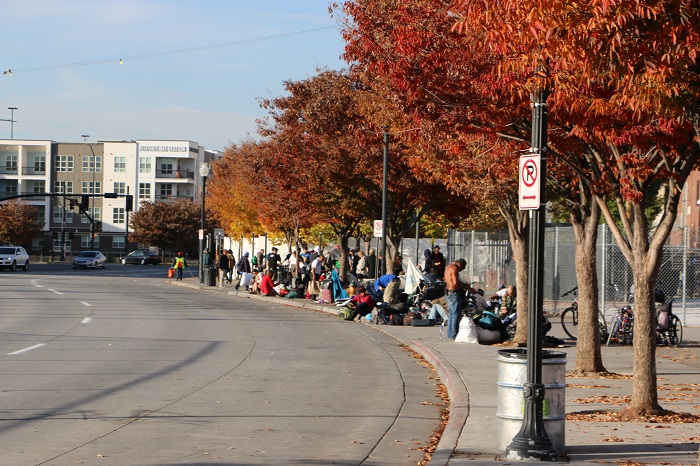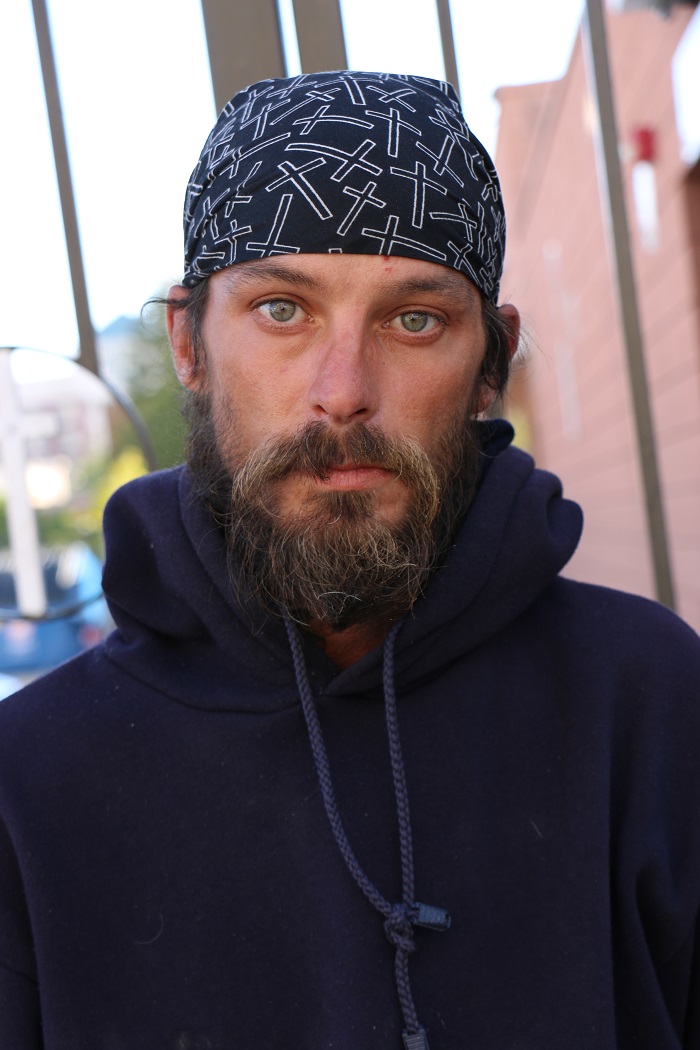Did you know that in 2015 Utah Solved the Problem of Chronic Homelessness?
In 2015, the national press (including NBC Nightly News, The Daily Show, The Washington Post, New Yorker Magazine and Ted Talks) were all celebrating how Salt Lake City had declared a victory over the war on homelessness. Apparently the homeless didn’t get the memo … or perhaps they did.
Crossroads Urban Center volunteer and Iraqi War Veteran, Rex Masters, offered some interesting insight.
“Do you know the place that is the most highly recommended city to move to for ex-convicts from the L.A. County Jail?”
“Vegas? New York?” I’m stumped.
“Salt Lake City,” he says. “They give them free one-way tickets to come here. They love kicking the can down the road.”
According to Masters, this practice is common in LA and other big cities because Salt Lake City is becoming well known for our compassionate homeless programs. “The homeless aren’t static; they don’t hold still. All they need is forty bucks to get on a Greyhound and move.”
Masters works at the Crossroads Urban Center while he is a full-time student at Westminster College, working on an MBA in nonprofit business. He believes the problem is worsening and that the current efforts of Operation Rio Grande will do little to nothing to solve the bigger issues.
But who can blame the homeless? If you were facing homelessness and you had the opportunity to go somewhere to get a fresh start, why not land in Salt Lake and get some help? So how did Salt Lake City earn this national recognition and destination acclaim?
In 2004, former corporate executive for Ford Motors and LDS Church leader, Lloyd Pendleton, took the lead in writing and implementing Utah’s ten year plan for ending chronic homelessness.
In 2006, Pendleton retired from his employment with the LDS Church and went to work for the state as Director of the Homeless Task Force to continue implementation of the plan to end chronic homelessness, with the aim of reducing overall homelessness by 2015. In nine years, Mr. Pendleton achieved his goals, whereby Utah claimed a victory over chronic homelessness with a 91% reduction.
As Utah’s Homeless Czar, Mr. Pendleton became a star. He was on the Daily Show with Jon Stewart. He was written about in national publications: New Yorker Magazine, Mother Jones, Fast Company. And his Ted Talk is a YouTube sensation. He applied his massive business brain to the problem of chronic homelessness, and voila!—problem solved!
This is the end of the story as far as the main-stream media is concerned. But it was around the summer of 2015 that I began observing a growing homeless population in and around Pioneer Park. Was I the only person making this observation despite the national media attention?
Two months ago, Pierre (the owner of Bruges Waffles) and I were talking about the growing problem when a shirtless, homeless man started rummaging in the restaurant garbage, tossing items on the ground with customers just feet away. After finding some discarded fries, Pierre firmly asking him to leave. He ignored the request, then asked Pierre for ketchup. Then Pierre said to me,
“You want a story? This is a story!”
A friend who works at SDI has personally witnessed the drug trade and the defecation around his building on 500 West worsening, and the SLCPD tell him and the people who worked there that they had no resources for handling all the drug dealers.
I was told by another inside source that our jails should install revolving doors for how quickly drug criminals are arrested then released, often without charges, because our Criminal Justice system is grossly overburdened, and the number of parole officers is far too low for the growing number of convicts they are supposed to manage. Some parole officers have up to 80+ convicts to keep track of.
Operation Rio Grande
Operation “Rio Grande,” according to the homeless people we spoke to, could be better named “Operation bulldoze the homeless out of an emerging high-end real estate market.”
Regardless of the methods, it’s working. The opinions, even among the homeless, regarding the efficacy vary as much as they do among city leaders.
If the main objective was to move the drug trafficking out of Pioneer Park and Rio Grande Street, and offer treatment for addicts, it’s been a success. Biking around the area, it’s clear that fewer people are blatantly using drugs out in the open, and far fewer day campers are loitering with massive piles of belongings. Certainly, the effort to decentralize the homeless population has been a worthy goal to make the area safer for residents and business owners. But has this hastily made plan really been an excellent “long-term, sustainable solution,” as the political leaders have sold it?
Project Rio Grande was spearheaded in part by Utah State Senator Greg Hughes, who helped to allocate $67 million to fund the two-year project. Hughes could be described as a politician/developer who has enriched himself facilitating and arranging deals to buy real estate around FrontRunner and Trax stops for Transit Oriented Developments (TODs). He is a great friend to his developer cronies who enshrine his power as Utah House Speaker with money.
However, Governor Herbert appointed Lieutenant Governor Spencer Cox as the leader of the initiative. All the local leaders, including SLC Police Chief Mike Brown, Mayors Biskupski and McAdams, seem very pleased for the State’s help.
High-end condominiums projects two blocks east of Gateway are currently under construction and the Salt Lake City building boom is clearly spreading west with hundreds of units currently under construction on 400 West. How much the bulldozing of the homeless has to do with Hughes and his developer cronies is unknown.

But in July and August, the street directly across from the Gateway could be accurately described as a slum. Huge piles of belongings were being stored under tarps and in makeshift dwellings. With the population increasing, the job of effective policing with limited resources was becoming dangerously impossible. The stories leading up to Project Rio Grande have been well covered by the local press, but we thought we would begin by asking a different question.
Over the same period that chronic homelessness decreased by 90% our veteran population increased by 100%. How and why did this happen?
According to current statistics Salt Lake City still has around 200 total chronic homeless, and 2,000 total homeless. Who are these additional 1,800 people? According to Masterson, the numbers aren’t accurate. There were over 5,000 different people who checked into the Crossroads Urban Center, and far more transient homeless that go unaccounted. So why hasn’t this been reported? Perhaps it’s because nobody is talking to the people who are supposedly the problem.
Voices of the Utah Homeless

Ben grew up in Utah. He calls his fellow homeless friends his “brothers” and “sisters”. Photos by Richard Markosian.
I decided to go out on a very warm fall afternoon on three occasions and speak to the homeless in and around the park and at the shelter. With camera in hand, I was anathema to most.
Isla is a homeless woman with a pet raccoon who tells me, “It’s considered a felony to own a raccoon, but once the officers got to know Destiny, they all liked her.”
Isla says that the police were very rude when Project Rio Grande began, but now they know her and Destiny, who is tame and allows me to pet her. She says that UHP is accommodating to her, and they are helping get Destiny certified as a service animal so she can go in the shelter, which currently only allows service dogs. She has to find a way to make Destiny a service animal so she won’t have to sleep outside this winter. She says she could never give up “her baby.”
Isla became very upset when we talked about the changes in police protocol. “They don’t realize that I work for my money, I have a job. So when they just decide to take my belongings. They are taking the few things I have that I saved for.”
She said that when the project first started, she had recently saved her money from her job tending to porta potties, to buy a warm sleeping bag and a decent camping tent. She said these these were taken by the clean-up crew and thrown away.
In the park, Isla is joined by several others who want nothing to do with me. One man said he was jumped by the cops late at night when he was just walking to stay warm. “It was four against one, and they beat me. I don’t want my name or photo anywhere,” he insisted.
In front of the woman’s shelter I interviewed two ladies who were also upset by Operation Rio Grande, mostly the area known as the “safe space.” They called it a concentration camp, and they especially don’t like the requirement to be IDd when entering and exiting.
A huge tent was erected surrounded by chain link fence, which requires special ID to enter after hours. The facility was designed to be a place for the homeless to day camp instead of Pioneer Park. On the day we were there, one single man was resting under the giant tent. Why isn’t the safe space being used?
“We are locked in here like criminals and we can’t get in and out,” said one woman we spoke with, who had contracted a staph infection from the bed bugs in the Road Home. It’s unsanitary. It’s cleaner in the park. “Why don’t they spend some money so we don’t have to sleep in a contaminated facility?” she inquired.
One young lady in Pioneer Park, who didn’t want her photo taken, was from South Jordan. Just 20 years old, Missy says she is “homeless by choice.” Which is a common answer among everyone I interview who appears young and capable. Missy says, “I couldn’t put my family through my addiction to heroin and meth any longer. They know I’m here.”
Missy has an attractive face and a pleasant demeanor. She is articulate and passionate. I’m amazed she is here. She says she was arrested on the first day of Operation Rio Grande, and adds, “If the cops wouldn’t have arrested me, I would have likely died. When I was picked up, I was just 87 pounds.”
Her drug use almost killed her, but staying in the treatment bed for two weeks saved her life, where she says she gained 30 pounds. “I’m using a lot less now,” she says. Missy has just a very small satchel which contains all of her belongings. She doesn’t sleep in the shelter. Instead, she walks around all night and sleeps during the day.
Nick and Deserea were with Missy. Husband and wife, they have been homeless about a year. They have kids who they hope to return to raise once they can get clean and find jobs. Nick says he’s been in and around drugs his entire life, and that they are unable to rent an apartment or keep jobs. They agree with Missy that Operation Rio Grande “was necessary.” Deserea agrees. “I was really scared to walk around here. Now, once in awhile, you see families out here.”

On Rio Grande Street, I meet Ben who is one of the few who believe me that I’m there only to gather stories. He tells me that C.I.s (Criminal Informants) are very common, so nobody trusts outsiders. He also tells me he is “homeless by choice,” and that he chose to be homeless rather than put his family through all that he is dealing with. Ben says he is bipolar and schizophrenic, and he can’t get the meds he needs.
Ben’s gruff unkempt exterior reveals thoughtful eyes. He says he hangs out here because, in his words, “These people are more than just friends to me, they are my brothers, and family.” They all look out for and protect each other. He calls several out by name, and attempts to convince them to “speak out about what is going on.”
One friend says project Rio Grande is “bullshit.” It’s only spreading out the problem and causing more homeless to move to areas where they will commit more crime. “We come here only because we can’t go anywhere else, and they are telling us we can’t be here. Where are we supposed to go?” If the Wasatch Front sees an increase in crime, it’s because of how this situation is being handled. “What are we supposed to do when we are out of options?”
Ben says he has been arrested several times by Operation Rio Grande officers, “And every time they arrest me they take all of my money.” He says he finds ways to do work and save some money and “they always take it all or half of it when I get booked.” This, he says, is because he has an outstanding conviction which was a “pay to stay,” which means he still owes $7,000 for his time spent behind bars. “That’s how they justify stealing from me.”
Ben introduces me to Linda who has received her housing from the state. She was one of the chronically homeless, but she comes back to Rio Grande to hang out with her friends.
I met Arturio who is from Mexico. His clothes appear clean, and his facial hair and haircut are well kept. He doesn’t appear homeless, but he claims he is there to hang out with his friends. And he chose to be homeless. He can cook Italian food very well and can easily get a job, but he sleeps in the shelter despite the fact that his parents and siblings all live in Salt Lake City. My guess is he is probably facing a recent drug addiction, but he says he is currently clean and sober. I believe him.
Arturio was recently hired to reseed areas in Washington that were affected by wildfires and he would leave in a couple of days. “But,” he says, “some of the police are nice and look out for you, but some are total assholes and they just want to harass you and throw you in jail.” He calls them more profanities, but he always gets out of jail in one day, so he’s not really afraid of them.
Despite our attempts to speak to political leaders, they didn’t want to go on record with one-on-one interviews. They believe they have said what needs to be said in their press conferences. We will attempt in the coming months to speak with them and get their side of the story.
Conclusion
When the media is focused on numbers without actually examining the facts on the ground, inaccuracies in reporting occur. To everyone in Salt Lake with eyes, there was a disconnect between the fiction of celebrating an end to homelessness and the reality that our homeless population was growing and becoming more aggressive.
Poverty and homelessness are conditions of the spirit as much they are a condition of people without homes. Three capable young people told me they are “homeless by choice.” If it is their choice to be transient and without a home, there is nothing the government can functionally provide to end the condition. Certainly, housing, medicine, beds, food, and compassion help. But nothing will stop a person from using drugs and continuing down a self-destructive spiral, unless they choose to change.
The story of Lloyd Pendleton illustrates that there is no magic pill to cure homelessness. And to act as if there is, or to celebrate a solution that doesn’t actually work, only attracts the most vile creatures to come and join our phony party in Salt Lake City. Mr. Pendleton must have known that the numbers weren’t real. Perhaps now he should be much more involved in the clean up effort. Like going back to the mainstream media and saying, “Umm, well, I was wrong.”
Sources For This Story
————————————————————————-
Fast Company Article on Lloyd Pendleton
Link to Nation Swell Article (Utah’s Homeless Czar)
The Daily Show with Jon Stewart and other Media for Lloyd Pendleton
Housing and Urban Development Stats on Homelessness in each state
Salt Lake Tribune Article on The Rio Grande
Census Report on Fastest Growing States
Who Determined that Utah saw a 97% decrease in chronically homeless in 2015?
End Homelessness shows Utah had a 1.8% decline in homelessness from 2015 to 2016
They report a 27% decline in change in overall homeless — which is nearly on par with Idaho.
They report a 53% decline in chronically homeless, (a discrepancy with figures reported by 43%)
They report a 6.3% increase in the homeless veterans
National Homeless.ORG reports that HUD Creates a disincentive to count all homeless people
Utah Has Eliminated Homeless Veterans
Prior to 2009, Corinth says, Utah mistakenly counted clients in transitional housing (semipermanent housing for up to two years) as chronically homeless. This inflated Utah’s chronic homeless numbers. When the mistake was corrected in 2010, the correction created an illusion of sudden and dramatic progress.





